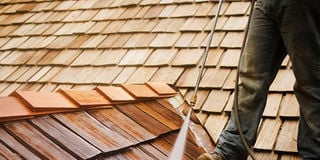The art of cleaning roofs

High pressure wash is chemical-free. PHOTO/www.gettyimages.com
What you need to know:
Roof cleaning is good for the health of your household but before embarking on the exercise, consult a professional roofing contractor for an assessment.
There are several roof types in Uganda, which include but are not limited to metallic / iron roof sheets, the clay roof commonly referred to as mategula and the shingle roofs, a more common addition to the roofing options of late.
As you walk around your neighbourhood, you may have noticed several houses with clay roofs/tiles whose colours look different. Alvin Andrew Muhumuza, operations manager, Advance Exterior Kleaning Solutions, says these colour variations are due to living organisms called algae which grow on roofs in areas where water or moisture collect. For the case of iron sheets or metallic roofs, Muhumuza says the original colour is lost due to the dust that is our daily companion.
Cleaning technique options
To restore these roofs to their original or even better condition, he says roof cleaning is necessary and employs the following methods:
● Soft wash
The method is gentle, relying on the use of industrial chemicals and equipment that is safe for your roof. “A low-pressure rinsing system, which is effective in getting rid of algae, moss and lichens completely, is used and is ideal for shingles and clay tiles,” Muhumuza shares. On average, a three bedroom house can be cleaned in less than six hours. However, he says the cleaning product used (usually bleach) can harm any vegetation it gets in contact with. “Your roofing contractor should therefore water any nearby plants and cover them to protect them from chemicals before cleaning your roof. This also applies to the underground water storage systems,” Muhumuza explains. Given that the cleaning products used are expensive, the method is quite costly compared to other cleaning methods.
● High pressure wash
The technique employs hot or cold water to clean the roof surface. “High-pressure cleaning is environmentally friendly as it doesn’t require chemicals or detergent. However, it doesn’t completely get rid of the organisms,” Muhumuza, points out. With a professional roof cleaner, it takes one to four days to clean the roof depending on the size of the premises. The method is a favourite for many because it is affordable.
● Manual contemporary wash
He says this is the most common method used in Uganda where one removes the tiles from the wooden structure, cleans them from the ground and replaces them onto the apex of the residence. “This method is outdated, costly, time wasting (one to two weeks) and causes a lot of damage,” he says.
Rationale of cleaning a roof
Homeowners do a lot to keep their homes clean and fresh but oftentimes, many forget about the roof cleaning yet it is vital. “The most important reason to clean your roof is to protect the health of your family because many people are constantly in hospital due to infections or allergies. Little do they know that the major cause is the moss-infested roof and gutters, especially risky for the elderly,” Muhumuza shares.
The tiles (usually made from clay or soil) are a food source for moss and algae and Muhumuza says the longer the moss and algae are left, the more they multiply, in addition to damaging the roof. “This enables them to eat through your tiles; weakening and rotting the roof progressively leaving the roof vulnerable during adverse weather conditions as the tiles can easily fly off. Moreover, the odour of rotting wood from the trusses attracts animals, potentially into your loft or attic. This ultimately leads to roof leakages,” he says.
Muhumuza adds that cleaning your roof occasionally is much cheaper than replacing the roof after extensive damage.
Your roof, like your home, is a portrayal of your personality and style yet sometimes, the build-up of algae and moss on a roof can make the shingles look worse than they really are.
Precautions taken before and during cleaning
Muhumuza says they have harnessed technology and equipment in order to deliver efficient safe services. “It is vital to discuss the safety of a client’s family and contractors’ staff before entering into a roof cleaning contract,” he says
Precautions include but are not limited to customisation of safety mechanisms during work, based on the risk assessment of the house in terms of size, terrain, surrounding, and drainage systems. “This covers protection during work at height, environmental preservation for collection of the waste water during work, limitation of access to work site by children, and people of the home,” he explains.
Deterrents to roof cleaning
Muhumuza says the major factors affecting roof cleaning include the extent of damage, pitch of the roof, square footage of the premises, the availability of water and electricity in your area. “Each of these is a potential deterrent for a roof cleaning assignment. It is therefore important to seek the opinion of a professional roofing contractor before a critical decision about your roof is made,” he says.





